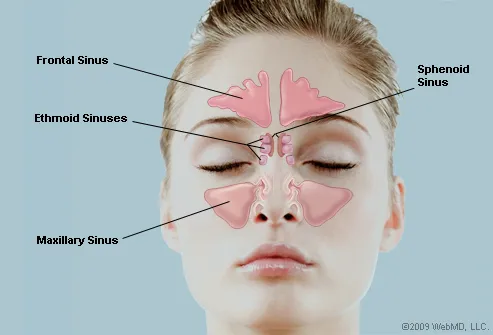Almost everyday I have a patient who comes & says "I have got sinus doctor"
Actually what they mean by that is having nose & sinus related issues or may be a simple headache.I thought to do a simple write up about sinusitis.
What are sinuses?
Sinuses are air filled cavities in our skulls.There are four pairs of sinuses.The maxillary,ethmoid,frontal & sphenoid.The purpose of sinuses is to moisturise the air we breath,keep our head lighter(due to air in them-hence when they are filled with mucus we get heavy headed) & they also enhance our voice.
The sinus cavities include:
• The maxillary sinuses (the largest), in the cheekbones.
• The frontal sinuses, in the low-center of the forehead.
• The ethmoid sinuses, between the eyes, at the nasal bridge.
• The sphenoid sinuses, in bones behind the nasal cavity.
 What is sinusitis or sinus infection?
Sinusitis is inflammation or infection of sinuses which could be allergic,viral or bacterial.
The common symptoms are
What is sinusitis or sinus infection?
Sinusitis is inflammation or infection of sinuses which could be allergic,viral or bacterial.
The common symptoms are
- Increased mucus production,
- nasal congestion,
- discomfort in the cheeks, forehead or around the eyes
- headaches .
If the nasal septum is deviated to far or there are nasal polyps or obstruction of any kind,it will lead to blockage in the free flow of nasal mucus & eventually sinusitis.
How do we diagnose sinusitis?
Diagnosis is usually done clinically by your symptoms & examination of the nose.In the nasal examination, we look for inflammation, mucopus & any obstruction or swellings.There can also be associated facial tenderness over sinuses.
Role of nasoendoscopy in the opd is to add to the information given by patient & is more useful for looking for polyps & other obstruction which cannot be easily picked up by anterior headlight examination.
If your symptoms do not clearly indicate that you have sinusitis or if they
persist for a long time and do not get better with treatment, we may order a CT (computerized tomography) scan to confirm that you have sinusitis.
To look for causes of chronic sinusitis ,we may order blood tests,take a sample of nasal mucopus or order sweat test.
What is the management of sinusitis?
Most of the acute sinusitis resolve with nasal decongestion,treatment of nasal allergy & symptomatic pain treatment.However if the symptoms do not resolve with above -antibiotics are given.
Chronic rhinosinusitis is often a challenge to treat.
Medical treatment is offered first in the form of
Nasal steroid sprays
A long course of antibiotics is occasionally recommended
Saline (saltwater) washes or saline nasal sprays can be helpful in chronic
rhinosinusitis because they remove thick secretions and allow the sinuses to
drain.
Oral steroids, such as prednisone, may be prescribed for severe chronic
rhinosinusitis especially if allergy is suspected.
Surgical Treatment is offer if medical management fails.
The goal of surgery is to improve sinus drainage and reduce blockage of the
nasal passages. Nasal surgery usually is performed to accomplish the
following:
- Enlarge the natural openings of the sinuses
- Remove nasal polyps
- Correct significant structural problems inside the nose and the sinuses if
they contribute to sinus obstruction
Although most people have fewer symptoms and a better quality of life after
surgery, problems can reoccur, sometimes even after a short period of time in allergics.
In children, problems can sometimes be eliminated by removing the adenoids.
These gland-like tissues, located high in the throat behind and above the roof
of the mouth, can obstruct the nasal passages.
What are the complications of sinusitis?
Complications are rare. However, they can be serious. For example, infection may spread from a sinus to around an eye, into bones, into the blood, or into the brain.
These severe complications are estimated to occur in about 1 in 10,000 cases of acute sinusitis. They are more common with infection of the frontal sinus.
Children are more prone to complications than adults. Swelling or redness of an eyelid or cheek in a child with sinusitis should be reported urgently.
How can sinusitis be prevented?
There are no methods that have been scientifically proven to prevent acute or
chronic sinusitis. However following
measures can help:
- Keep your nose as moist as possible with frequent use of saline sprays or
washes.
- Avoid very dry indoor environments and use a humidifier, if necessary. Be
aware, however, that a humid environment also may increase the amount of mold,
dust mite, or cockroach allergens in your home; this is important only if you
are allergic to any of those organisms.
- Avoid exposure to irritants such as cigarette and cigar smoke or strong
odors from chemicals.
- Avoid exposure to substances to which you are allergic.
- If you haven’t been tested for allergies and you are getting frequent sinus
infections, an allergy evaluation
may help.
- Avoid long periods of swimming in pools treated with chlorine, which can
irritate the lining of the nose and sinuses.
- Avoid water diving, which forces water into the sinuses from the nasal
passages.
